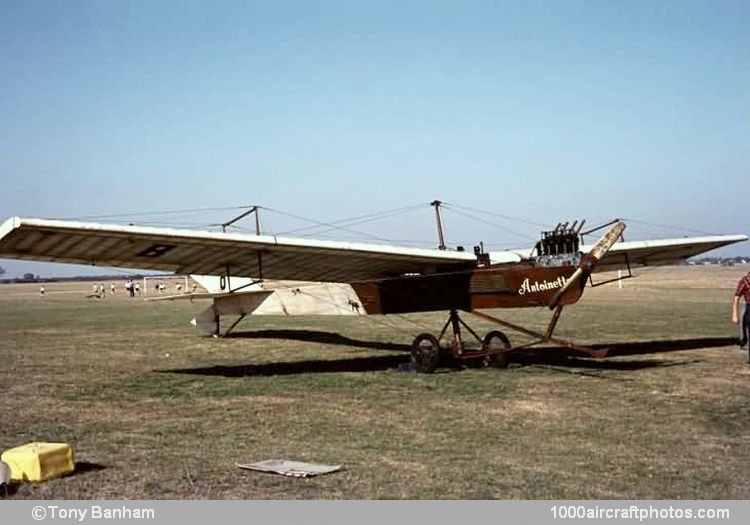11/30/2013. Remarks by Johan Visschedijk: "The Antoinette IV, designed by Léon Levavasseur at the Société Anonyme Antoinette of Puteaux, France, first flew on October 9, 1908. This single machine was radically modified over a short period of time: changes could have been made even within a few hours, making photographic sequencing nearly impossible. All versions shared the long triangular-sectioned fuselage of the later Antoinettes, similar wide trapezoidal wings, centrally-mounted landing gear and triangular sail-like tail surfaces; the Antoinette IV was the only model with ailerons, the rest having warping wings.
The following brief sketch of Léon Levavasseur's design progression of the first Antoinette IV is an estimation; some of the features described here overlapped across several changes. The first landing gear consisted of two wheels on what looked like enlarged bicycle forks, in tandem; triangular ailerons hung loosely, with loose fabric for the trailing edges. The rudder was a rectangular panel between the forward triangular fin and a trailing triangular fin, and the elevator corresponded to it, without the trailing surface.
Then the landing gear was reversed with a single trailing wheel set into the rear of a long skid girder which had a small wheel set out in front of the tip. The rectangular elevator was fixed, and a triangular surface was hinged behind it. The name Antoinette was painted on the sides of the radiators. Further changes included a roller set into the front of the skid, the rectangular rudder taken out and the familiar pair of triangular rudders substituted, the familiar spoked control wheels appeared on the sides of the cockpit, the nose was covered, and small wheels were fixed to the wing tip skids.
Then the bracing mast was set right above the landing gear strut; the familiar long diagonal skid replaced the horizontal girder; and a close-set pair of wheels were fitted on a cross-axle. Then the fuselage, at least, must have been re-covered, since diagonal tapes showed between the diagonal fuselage bracing, giving a series of diamond patterns; a small wheel was set the tip of the skid.
A curved wooden fairing was added to the bow and another fastened to the forward landing gear brace. Frenchman Hubert Latham attempted the Channel crossing in it when the fuselage veneer extended to the rear of the side radiators, the diagonal nose wheel strut had been re-set, and the trailing wing skids had been taken off. The machine was destroyed when it crashed in the water.
At Reims in August 1909 another Antoinette, very similar to Latham's No. IV, was entered with the number 13 painted on the sides. It differed from Latham's in having a second horizontal brace in the landing gear, and lacked the little nose wheel on the skid. In the Champagne meet later the same year, this machine appeared again, with a second diagonal brace crossing the skid, now fitted once more with the nose wheel.
Ferber had designed the controls, consisting first of a left-side-mounted wheel for ailerons and rudder, a right-side-mounted wheel for elevator, two small wheels in front of the pilot for engine controls, and a foot-pedal with the ignition switch. Revised, the controls were similar, except that the foot-pedal now controlled the rudder. Levavasseur was said to have been asked why he retained such a complicated system, and he replied that flying was not simple, either. But his machines proved very stable and easy to fly, in spite of his control system.
The wing plan was of the type known as 6:3:2 (each panel had a 6 m (19 ft 8.2 in) span, a 3 m (9 ft 10.1 in) chord at the root, and 2 m (6 ft 6.7 in chord at the tip). The dimensions of the machine remained generally unchanged during its lifetime; in August 1909 they were described as follows: Span: 41 ft 11.9 in (12.80 m), airfoil symmetrical front and back, angle of attack: 4°; length: 39 ft 4.4 in (12 m); wing area: 365.97 sq.ft (34 sq.m); empty weight: 1,014 lb (460 kg); 50 hp Antoinette eight-cylinder V-engine.
After Antoinette IV was completed and before it was sent to the Channel, at least four other Antoinettes had been built, No. V, VI, VII, and VIII, the latter flying in August 1909. Little is known about No. V, VI, and VIII. Since No. IV and VII were progressively retrofitted with the latest improvements, it is reasonable to suppose the same occurred with the other three, unless they were abandoned too early for this process. No. V and VI were similar to the first versions of No. IV.
Antoinette V: It was built for Demanest with more aluminum parts, especially in the wing, than were used in No. IV. It had trapezoidal ailerons, closely-paired wheels at the rear of the heavy girder skid with a front-mounted roller, no forward under-fin, and a curved cut-out at each wing root. It had a span of 41 ft 0.1 in (12.50 m) and a length of 35 ft 5.2 in (10.80 m).
Antoinette VI: This one was built for Captain Burgeat, at first with ailerons. These were later removed and replaced by a wing-warping system which proved more effective and which was used in No. VII. With Levavasseur's system, the front spar was fixed and the rear one could pivot up and down. There was a control wheel on the right side as on all Antoinettes, but a second one was mounted like a steering wheel in front of the pilot, with a cushion between him and it.
In 1909 the design was licensed to a number of aircraft pioneering companies, including the Albatros Flugzeugwerke at Berlin-Johannisthal, Germany. The above pictured replica was built by Hants and Sussex Aviation of Portsmouth, Hants (an abbreviation for Hampshire) in 1964 for the filming of the movie "Those Magnificent Men in their Flying Machines"."
